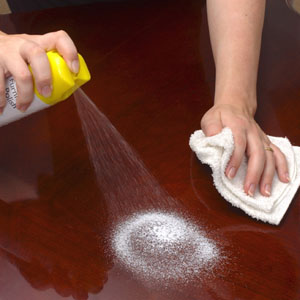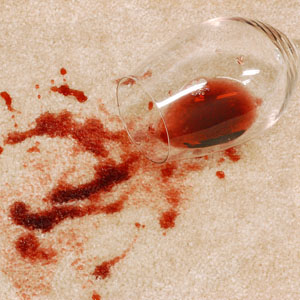Being prepared for spills and accidents will ensure easy clean up and no permanent damage to your home and furnishings.
To the Rescue
Try these quick problem-solvers for common furniture mishaps:
Problem: Scuffed up table legs
Solution: "Use matching-color shoe polish," says Cliff Spencer Furniture spokesperson Leigh Kivowitz Spencer. "Applied with a soft cloth, you can try it on an overused tabletop or frequently-kicked table legs. And if you don’t like the way it looks, just remove it with mineral spirits."
Problem: Rip in a sofa cushion
Solution: Although there's no easy fix, Tom McNulty, author of Clean Like a Man—Housekeeping for Men (and the Women Who Love Them), suggests gluing a matching piece of scrap fabric (taken from a matching toss pillow or from the underside of the sofa) with fabric glue or darning the tear with a needle. When all else fails, drape a throw over the offending spot!
Problem: Carpet spill
Solution: Experts recommend that you go into emergency mode and sop up as much of the liquid spilled as possible right away. Next, spray down the area with a mixture of mild soap and vinegar. Press down more and repeat. Finally, place a few paper towels over the cleaned-up stain overnight with a heavy book on top to press out any hidden liquid.
-
Furniture First Aid
Quick fixes to ensure your furnishings survive stains, spills and scratches.
- by Jacqueline Rupp
Accidents happen. Spills, scratches and rips occur no matter how careful you are. Unfortunately, one wrong move—a spilled glass of red wine or an accidental table scratch—can mean the end of a prized piece of furniture. Instead of stressing over the accident, take charge and reach for a quick-fix repair.
Say “So Long” to Spills
Don't let that red wine on your white loveseat spoil your dinner party—or your loveseat. There are definitely better solutions than flipping the cushion over (after all that's only good for the first stain!).
Tom McNulty, author of Clean Like a Man—Housekeeping for Men (and the Women Who Love Them), says it’s important to know what the fabric content is before beginning any cleanup. His solution to the wine spill disaster? Club soda. "This works on most but not all fabrics,” he says. “Never rub a spill, just blot. Rubbing can break the fibers and spread the stain." McNulty adds that this technique should not be used on microfibers or ultrasuede. For these fabrics you should follow the manufacturer’s directions—which are often to use an extra-gentle soap or invest in a microfiber fabric cleaner.
No-Stress Scratches
As beautiful as wood furniture is, just one scratch (inevitably in a prominent place) can diminish its beauty. And unlike a spill, you can't just wipe a scratch away. Instead, you need to find a method to replace the color or wood that has been accidentally removed.
Cliff Spencer Furniture spokesperson, Leigh Kivowitz Spencer, explains that it's important to know what type of wood you are dealing with before trying to fix the scratch. "For a lacquer finish, I recommend Tibet almond stick,” she says. “You can also buy colored waxes or stain pens"
She says to go for gentle solutions and avoid ones that involve applying heat to the surface. "If you know your furniture was finished with Tung or linseed oil, the process is much easier,” says Spencer. “You can sand lightly and reapply the oil." She adds that the same applies to pre-prepared oil wax finishes (like OSMO): "The touch-up is much easier; simply use the finish."
As a rule of thumb, Spencer says harder finishes are tougher to repair. "A more natural finish, that is less 'durable,' the kind that needs a little more maintenance (like yearly oiling) is actually longer-lasting when it comes to holding up to scratches."
While they won’t repair scratches, furniture markers may help hide them. They aren't just a gimmick, they can actually work well to hide scratches, adds McNaulty. "To match the color, take a digital photo of the surface,” he says. “Or, if possible, take a part of the piece (like a drawer) to the store." He advises avoiding furniture crayons though.
When Bad Things Happen to Good Tables
Scratches aren't the only damage we can inflict on wood. Tables in particular are susceptible to the dreaded "white ring." The usual culprit is a glass or mug, and is caused by moisture or heat pressed onto the furniture's finish. McNaulty offers several cures for this stain. He advises to try furniture polish first and, if that doesn't work, trying plain toothpaste or steel wool to buff the area. If these solutions don't work, "the spot may just need rewaxing,” he says. “Rub with mineral spirits, apply wax and buff." McNaulty warns though that a ring darker than the finish can mean permanent damage that requires professional care.



